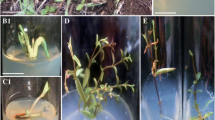Summary
Micropropagation is a technique to ensure a constant and uniform source of medicinal plants. In this report, we describe the micropropagation of Lepidium virginicum L. (Brassicaceae), a wild plant used as an antiamoebic in traditional Mexican medicine. In vitro-germinated seeds were cultured in Murashige and Skoog (MS) medium to obtain pathogen-free cotyledons, hypocotyls, and apical bud (AB) explants. For induction of morphogenesis, the effect of cytokinins, benzyladenine (BA) and kinetin (KN), combined with auxin, indole-3-acetic acid (IAA) was evaluated. The best rate of shoot proliferation was induced 15 d after culture on MS mineral medium supplemented with IAA∶KN (0.57∶13.94 μM) from AB explants. Maximum shoot elongation was achieved without plant growth regulators. The effect of indole-3-butyric acid (IBA) (14.76 μM) was evaluated for in vitro root induction; 60 d after culture all the shoots had developed roots. All rooted plants were successfully transferred to pots and 100% acclimatized in ex vitro conditions. The methanol extracts from the micropropagated active explants of L. virginicum showed and IC50 antiprotozoal value between 141.90 and 268.53 μg ml−1.
Similar content being viewed by others
References
Alanís, D. A.; Calzada, F.; Cedillo-Rivera, R.; Meckes, M. Antiprotozoal activity of the constituents of Rubus coriifolius. Phytother. Res. 17:681–682; 2003.
Aguilar, C. A.; Camacho, J. R.; Chino, S.; Jacques, P.; López, M. E. Herbario Medicinal del Instituto Mexicano del Seguro Social Información Etnobotánica. México: Instituto Mexicano del Seguro Social; 1994:70–71.
Argüeta, V. A.; Cano, A. L.; Rodarte, M. E. Atlas de las Plantas de la Medicina Tradicional Mexicana. Tomo II. México: Instituto Nacional Indigenista; 1994:900–901.
Berlin, E. A.; Berlin, B. Medicinal ethno biologh of the Highland of Chiapas. The gastrointestinal diseases. Princeton, México, Princeton University Press; 1995:183–189.
Calzada, F.; Alanis, A. D.; Velázquez, C./ Barbosa, E.; Cedillo, R. Antiprotozoal activity and chemical investigation of traditionally used medicinal plants in the treatment of dysentery and diarrhoea in Mexico In: Revista de Fitoterapia. Book of abstracts. 2:314; 2002.
Calzada, F.; Barbosa, E.; Cedillo-Rivera, R. Antiamoebic activity of benzyl glucosinolate from Lepidium virginicum. Phytother. Res. 17:618–619; 2003a.
Calzada, F.; Meckes, M.; Cedillo-Rivera, R.; Tapia-Contreras, A.; Mata, R. Screening of Mexican medicinal plants for antiprotozoal activity. Pharma. Biol. 36:305–309; 1998.
Calzada, F.; Velázquez, C.; Cedillo-Rivera, R.; Esquivel, B. Antiprotozoal activity of the constituents of Teloxys graveolens. Phytother. Res. 17:731–732; 2003b.
Cruz-Vega, D. E.; Aguilar, A.; Castro-Garza, J.; González-Garza, M. T. Antiamebic activity of aqueous extracts from five medicinal plants from northeastern Mexico. Arch. Med. Res. 31:S17-S18; 2000.
Cuenca, S.; Amo-Marco, J. B.; Parra, R. Micropropagation from inflorescence stems of the Spanish endemic plant Centaurea paui Loscos ex Willk. (Compositae). Plant Cell Rep. 18:674–679; 1999.
Diamond, L. S. Entamoeba histolytica Schaudin 1903: from xenic to axenic cultivation. J. Protozool. 33:1–5; 1986.
Ermel, K.; Pahlich, E.; Schmutterer, H. Azadirachtin content of neem kernels from different geographical locations, its dependence on temperature, relative humidity and light. In: Schmutterer, H.; Ascher, K. R. S., eds. Natural pesticides from the neem tree (Azadirachta indica A. Juss) and other tropical palnts. Eschborn: GTZ. Proceedings of the Third International Neem Conference; 1986:171–184.
Fracaro, F.; Echeverrigaray, S. Micropropagation of Cunila galioides, a popular medicinal plant of south Brazil. Plant Cell Tiss. Organ Cult. 64:1–4; 2001.
Ibañez, M. R.; Amo-Marco, J. B. Promotion by pholoroglucinol of micropropagation of Minuartia valentine, an endangered and endemic Spanish plant. Plant Growth Regul. 26:49–56; 1998.
Kapoor, K.; Chandra, M.; Nag, D. Evaluation of metronidazole toxicity: a prospective study. Int. J. Clin. Pharmacol. Res. 19:83–88; 1999.
Nissen, S. J.; Sutter, E. G. Stability of IAA and IBA in nutrient medium to several tissue culture procedures HortScience 25:800–802; 1990.
Orozco, E.; Lopez, C.; Gomez, C.; Perez, D. G.; Marchat, L.; Banuelos, C.; Delgadillo, D. M. Multidrug resistance in the protozoan parasite Entamoeba histolytica. Parasitol. Int. 51:353–359; 2002.
Osuna, L.; Lozoya, X. Plantas medicinales usadas por la medicina tradicional para el tratamiento de padecimientos gastrointestinales infecciosos. Rev. Médica del IMSS 27:305–309; 1989.
Osuna, L.; Pereda-Miranda, R.; Tortoriello, J.; Villarreal, M. L. Production of the sedative triterpen Galphimine B in Galphimia glauca tissue culture. Planta Med. 65:149–152; 1999.
Osuna, L.; Tapia-Pérez, M. E.; Aguilar, A. Plantas medicinales de la medicina tradicional mexicana para tratar afecciones gastrointestinales. Estudio etnobotánico, fitoquímico y farmacológico. España: Universidad de Barcelona; 2005:79–80.
Samarawickrema, N. A.; Brown, D. M.; Upcroft, J. A.; Thammapalerd, N.; Upcroft, P. Involvement of superoxide dismutase and pyruvate:ferredoxin oxidoreductase in mechanisms of metronidazole resistance in Entamoeba histolytica. J. Antimicrob. Chemother. 40:833–840; 1997.
Sing, R. P. Comparation of antifeedant efficacy and extract yields form different parts and ecotypes of neem (Azadirachta indica A. Juss) trees. In: Schmutterer, H.; Ascher, K. R. S., eds. Natural pesticides from the neem tree (Azadirachta indica A.Juss) and other tropical plants. Eschborn: GTZ. Proceedings of the Third International Neem Conference; 1986:185–194.
Villarreal, M. L.; Muñoz, L. J. Studies on the medicinal properties of Solanum chrysotrichum in tissue culture: 1 Callus formation and plant induction from axillary buds. Archivos de Investigación Médica 22:127–133; 1991.
Villarreal, M. L.; Rojas, G.; Meckes, M.; Nicasio, P. Studies on Mimosa tenuiflora callus culture, interaction of kinetin and 2,4-dichlorophenoxyacetic acid in initiation and growth. Biotech. Lett. 15:721–726; 1999.
Tiwari, S. K.; Tiwari, K. P.; Siril, E. A. An improved micropropagation protocol for teak. Plant Cell Tiss. Organ Cult. 71:1–6; 2002.
Author information
Authors and Affiliations
Corresponding authors
Rights and permissions
About this article
Cite this article
Osuna, L., Tapia-Pérez, M.E., Figueroa, O. et al. Micropropagation of Lepidium virginicum (Brassicaceae), a plant with antiprotozoal activity. In Vitro Cell.Dev.Biol.-Plant 42, 596–600 (2006). https://doi.org/10.1079/IVP2006826
Received:
Accepted:
Issue Date:
DOI: https://doi.org/10.1079/IVP2006826




